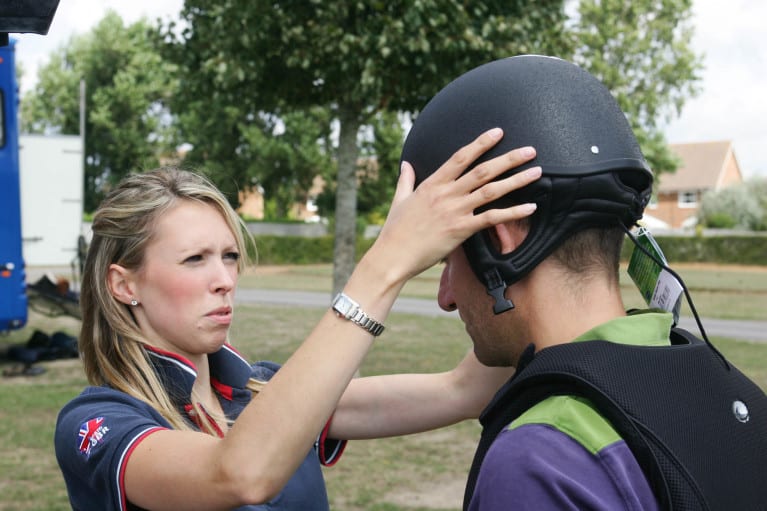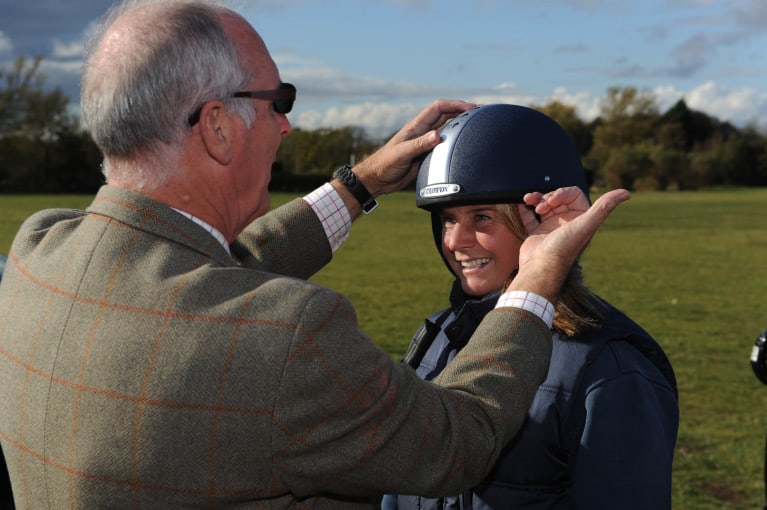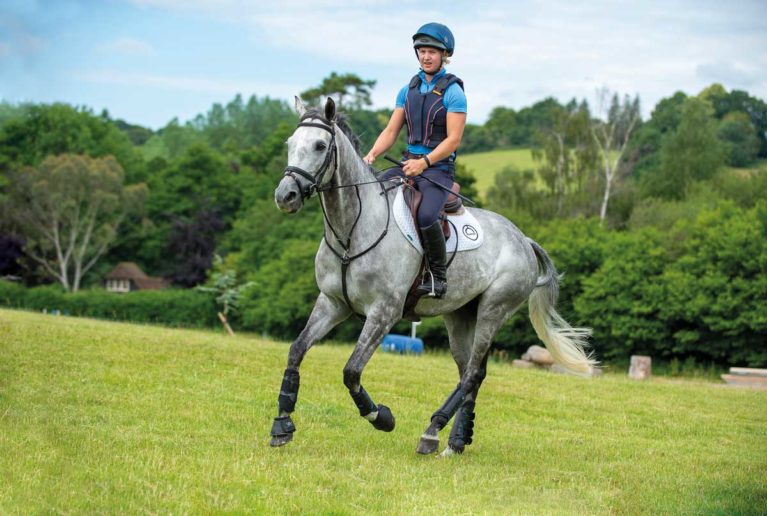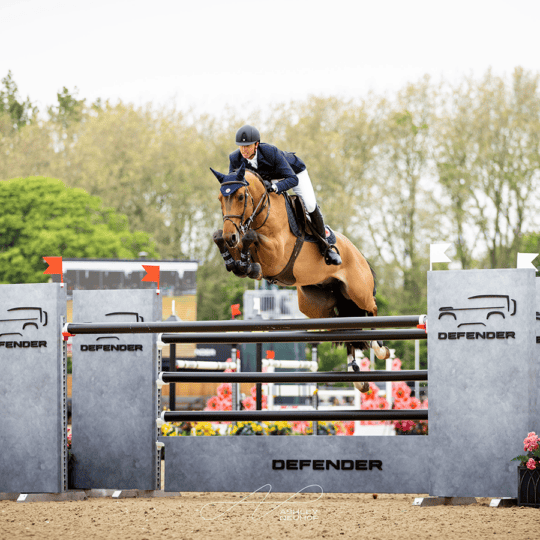

With the withdrawal of hat standard (BS)EN1384 at the end of 2014, there has been a lot of confusion about which hats you can wear and when you can wear them. Horse&Rider has rounded up a selection of hats on sale now that you can still compete in as of 2016, and speaks to technical experts to help make head and tail of the situation…
What is my hat made of and how does it protect my head?
There are three layers within your hat, each providing a different, specific type of protection. The outer shell is designed to help prevent penetrative head injuries caused by a sharp object, such as parts of a fence, if you fall against it. Helen Riley, Technical and Safety Product Manager at Design Headwear (Gatehouse), explains: “Depending on which standard your hat meets, the outer shell is likely to be made from fibreglass, possibly with carbon fibre or Kevlar for added strength, or a type of plastic called ABS.
“The shock-absorbent liner is most commonly made from expanded polystyrene – like tiny beads with air trapped inside. When there is an impact, the beads absorb and disperse the shock, and in doing so the liner becomes compressed and does not bounce back. Consequently, the performance of your hat will be reduced in that area, which is why hats should be replaced following a fall.”
Roy Burek, Managing Director at Charles Owen & Co (Bow) Ltd, adds: “The third layer is the woven band inside, which grips your head without restricting scalp movement. This ensures your hat stays in place during a fall, but allows nature’s own protective mechanism to prevent brain injury.”
What are the differences between the current standards – PAS015, ASTM F1163 and Snell E2001?
PAS015 is the only British standard, but all these standards keep your head safe and require an initial assessment of a new design – up to 30 hats are tested. Helen explains: “For each standard, there is a different test criteria that includes the number of hats tested and frequency of testing. However, all standards include a penetration test (except ASTM F1163), a stability test and a drop test onto a flat anvil. More challenging standards have a rigidity or crush test and a drop test onto a V-shaped anvil. Snell E2001 currently has the most severe test criteria – these hats are also tested at varying temperatures, and when wet and dry. As the testing is a destructive process, a hat that you have purchased will not have been tested, but if your hat carries a BSI Kitemark, then one in the same batch will have been tested for continued product quality.”
Roy adds: “With BSI Kitemark batch testing, eight samples are tested from a batch of 1,600 and the batch is only sold if all the samples pass all the tests. Each standard has an independent certification scheme so that the wearer does not have to rely on the manufacturer’s word that the hat complies.”
How long will it be until there is a new standard?
No one can be sure when there will be a replacement for (BS)EN1384, but it is estimated that it will be at least a year. Roy explains: “In the meantime, a Europe-wide consensus of hat testing experts has published a minimum performance requirement called VG1.” At the time of going to press, no governing bodies had decided whether riders would be permitted to wear hats certified to only VG1 in competition.
When do I need to buy a new hat and how should I care for it?
Tony Palkowski, Chief Technical Engineer at Champion Safety Wear, advises: “You should always replace your hat if you have a fall or it suffers an impact. If you are lucky enough to have avoided this, your hat should be replaced every three to five years, or sooner if it no longer fits. This is because the protective materials it contains will gradually deteriorate with exposure to heat and repeated use, and it will no longer offer the same level of protection.” Helen explains: “It will also depend on how often you use your hat, but over time the expanded polystyrene liner and comfort lining can compress slightly through general wear, so replace your hat if it no longer fits correctly. Hat technology also evolves continuously and it is best to take advantage of this.”
There are many ways to look after your hat that may often be forgotten. Your hat should be stored in a protective bag at room temperature. Ensure it is dry and if it is wet, then let it dry naturally – don’t put it on the radiator. Some hats now come with washable liners, but if yours doesn’t then use a damp sponge to remove any grime. Some companies also offer hat cleaners and deodorisers made for the inside of your hat.
Roy explains: “To provide the best protection, a hat is designed to be weaker than your head – so never do things to your hat that you wouldn’t think of doing to your head. Your hat is sensitive to extreme heat so never leave it in a car on a hot day or place it in direct sunlight. The heat will cause the polystyrene bubbles inside the hat to melt, therefore weakening its protective ability. I also advise never to put your hat in the dishwasher.”
What should I consider when buying a new hat?
There is so much choice available – once you’ve considered the standards and fit, there are all the colours and styles to get your head around. Tony advises: “First consider what activities you do with your horse and, if you are planning on competing under rules, ensure your chosen hat is up to the standard specified by the relevant governing body.
“It is also of paramount importance that the hat you choose fits properly and is comfortable for you to wear. Different brands fit differently and may suit different head shapes. Even within one brand, different styles of hat may fit slightly differently. To help make sure you choose the best hat for your head, it’s essential that it is fitted in-store by a qualified hat fitter. They will be able to guide you as to the best style and fit for your head shape and riding requirements. Remember that, when buying a new hat, it may feel more snug than the one you’re used to riding in. With wear and tear, the foam in your old hat will have worn and compressed slightly and, therefore, will feel looser than a brand new one.”
How will the standard of my hat affect when I can wear it to compete?
The removal of the (BS)EN1384 standard does not mean your (BS)EN1384 standard hat is no longer safe to wear – you can still wear it when you ride outside of competition, even in 2016, and your hat still meets the standard’s original criteria. However, many governing bodies and organisations will no longer permit the use of hats made solely to this standard after 2015. If, for example, your current hat conforms to (BS)EN1384 and PAS015 or Snell E2001, then it is fine to continue wearing in competition because it has passed the PAS015 and Snell E2001 tests, too.
Where does everyone stand on (BS)EN1384?
British Eventing, British Showjumping, British Riding Clubs and The Pony Club permit (BS)EN1384 hats until the end of 2015.
British Dressage permits the use of (BS)EN1384 until the end of 2016.
British Horse Society permits (BS)EN1384 hats until the end of 2015. From 1 January 2016, hats made solely to (BS)EN1384 will not be permitted for use in BHS-approved centres.










